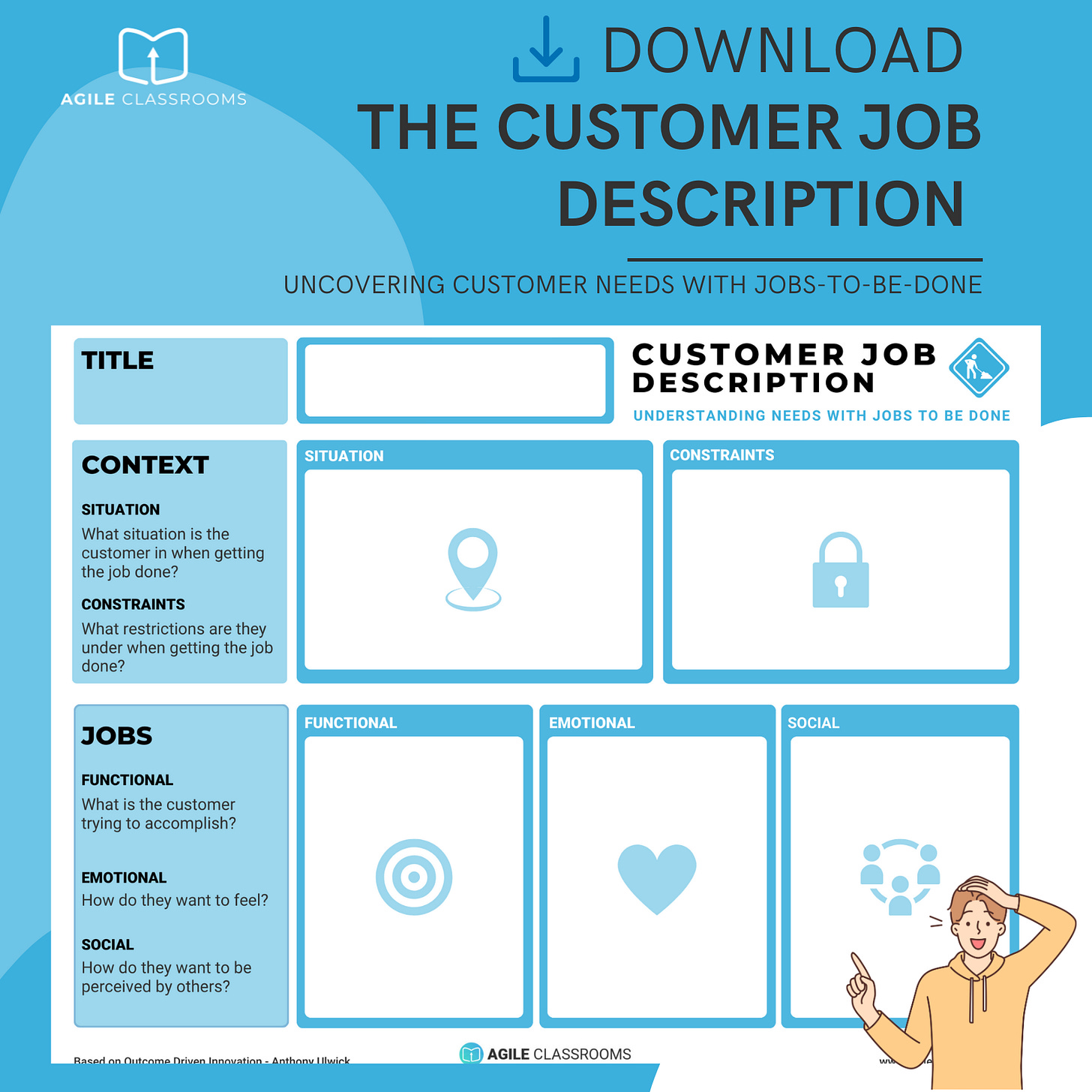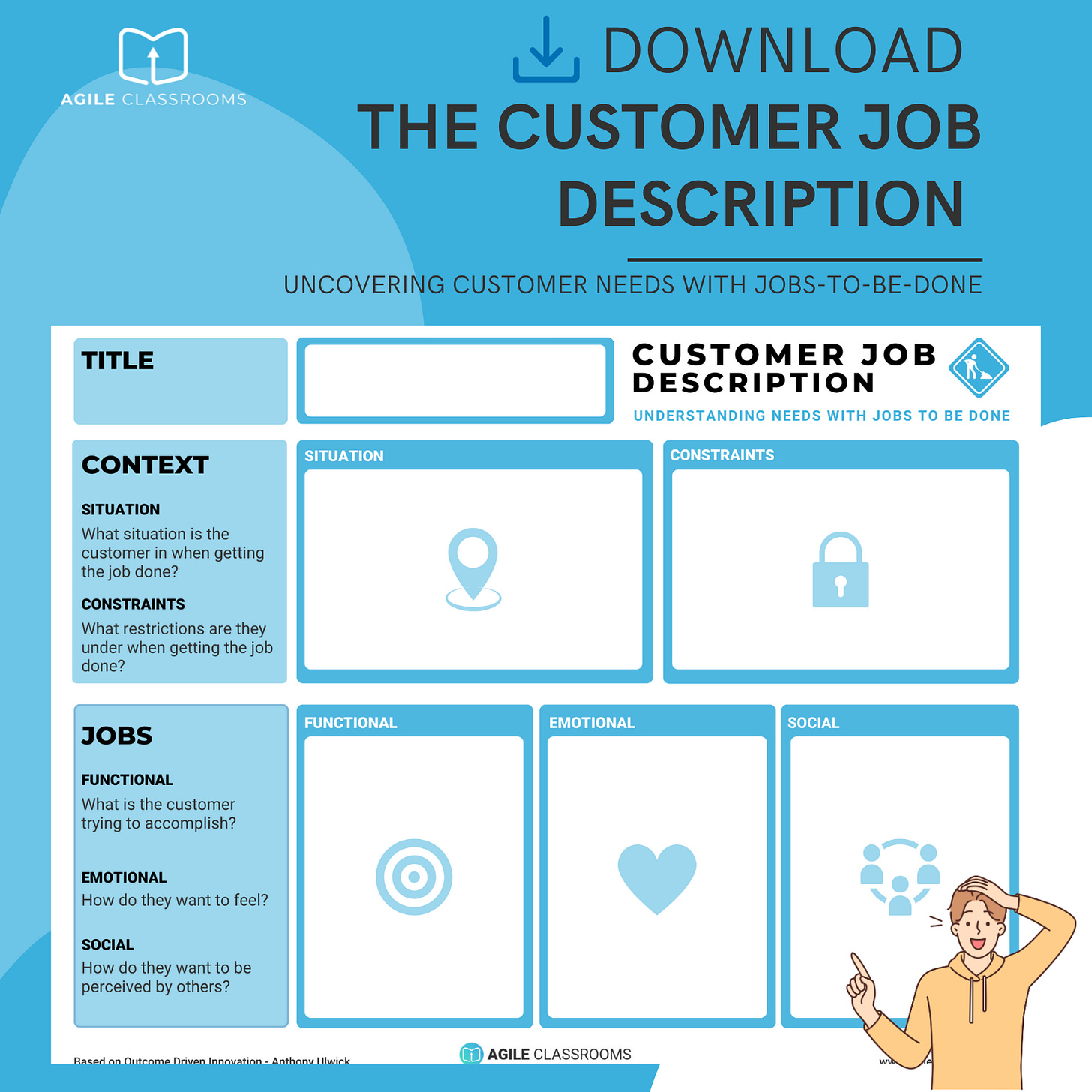The Customer Job Description
Mapping Customer Needs with Jobs-To-Be-Done
Introduction
Success hinges on a deep understanding of customer motives when developing successful products and services. The 'Jobs To Be Done' (JTBD) framework offers a powerful perspective, focusing on what customers genuinely aim to accomplish with a product. This article explores how the Customer Job Description template can simply JTBD so you can use it immediately to maximize the value of your product development efforts.
What is Jobs-To-Be-Done?
Jobs-To-Be-Done (JTBD) represents a transformative approach to understanding what drives customer choices in product and service innovation. This framework extends beyond traditional demographic analysis, diving into the specific goals or objectives—called 'jobs'—that customers aim to achieve with a product or service. These 'jobs' are more than mere tasks; they represent the customer's pursuit to accomplish something, be it solving a problem, fulfilling a need, or achieving a desired state.
In JTBD, customers see every product or service as a solution 'hired' to complete a specific job. These jobs may vary widely in nature, encompassing functional aspects (like completing a task efficiently), emotional dimensions (such as gaining confidence or satisfaction), and social implications (like enhancing one’s status or fitting in with a group). The focus is not just on who the customer is demographically but on what they are trying to achieve—what success looks like in their context and what obstacles they are trying to overcome.
By centering on these jobs, businesses can get to the heart of customer needs, crafting products and services that align with fundamental goals driving customer behavior. This deep alignment is critical to creating solutions customers will actually use, depend on, and advocate for, leading to lasting product success.
The Milkshake Story: JTBD in Action
Clayton Christensen’s milkshake story is a prime example of the 'Jobs To Be Done' framework in action. McDonald’s set a goal to increase their milkshake sales by 10%. Initially, they tried tweaking the product, enhancing flavors, and altering thickness, but these changes didn't yield the desired results. It was only when they started observing and engaging with their customers that real insights emerged.
During these observations, they noticed many customers purchasing milkshakes in the morning. Through interviews, they discovered that customers were selecting McDonald's milkshakes not just as a beverage but as a convenient and filling breakfast option. The milkshake had the unique advantage of alleviating boredom during the mundane car ride to work. It was a solution that was less about the product's physical attributes and more about the ‘job’ it was fulfilling: providing a mess-free, engaging breakfast experience that was easy to manage during a commute, unlike other quick breakfast options like donuts and bagels, which were consumed too quickly and could leave a mess.
This insight led to a strategic shift in how McDonald's improved, positioned, and sold their milkshakes, aligning with the customers' morning routines and addressing the 'job' these customers needed the milkshake to do. This more profound understanding of customer needs—gained through the JTBD lens—was instrumental in achieving the sales growth McDonald's was aiming for.
You can watch Clayton share the story himself in this video:
Introducing the Customer Job Description Template
Embracing the JTBD approach is transformative, yet applying it could be overwhelming. I needed a simple way to bridge theory and practice, so I created the Customer Job Description template. This template is a distilled version of the JTBD principles into a practical tool that has significantly aided me and many others in identifying and aligning with customer needs. It's been instrumental in focusing development efforts on features that customers truly value and use. Using the milkshake story, let's explore an example of using this template.
Title: Long Morning Commuter Eating on the Go
Situation: Driving on a long morning commute to work.
Constraints: Can only use one hand, only a cup holder to hold food.
Functional Job: Get and eat breakfast on the go.
Emotional Job: Feel engaged/alleviate boredom, feel safe while driving and eating, and feel comforted/rewarded.
Social Job: Avoid being judged for food choices and be perceived as a professional at work.
As you can see, there is not one mention of the product or features in the Customer Job Description. It peers inside the mind of the customer so you can develop better products for them. By keeping it solutions agnostic, we can generate more options for innovation than if we painted ourselves into a corner with premature feature ideation. Know thy customer before writing about features.
Customer Job Description: Bridging Insight and Action
This template is a practical tool for articulating and aligning customer needs, ensuring that development efforts focus on features that customers value and use. It has helped me to simplify the model and insights captured from customer discovery. The Customer Job Description tool directly targets the essence of customer value, serving as a visual guide to ensure our efforts are aligned with the customer's needs.
Embrace a deeper level of customer understanding with our Customer Job Description template. Download it now to leverage the JTBD framework for product features that meet customer needs. I hope it will prove as valuable for you as it has for me and the hundreds of others I have helped through coaching and mentoring.





